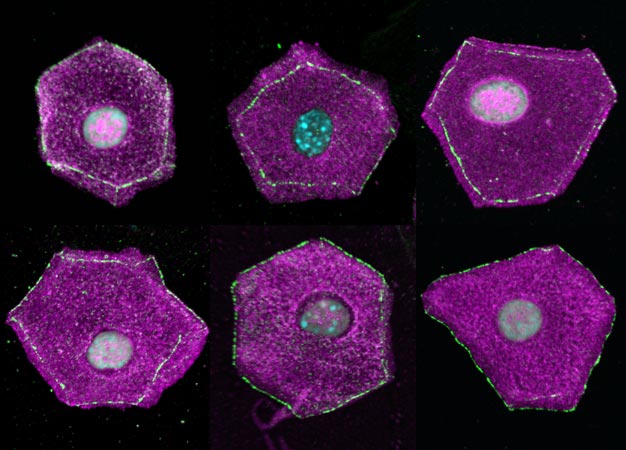Scientists discover the unusual geometry that holds mammalian skin together, even while shedding
Published online 23 February 2017

The 14-sided tetrakaidecahedron shape of epidermal cells (seen here from different angles) explains how the skin maintains a physical barrier against disease.
Reproduced from Ref. 1 and licensed under CC BY 4.0 © 2016 M. Yokouchi et al.
The human body sheds an estimated 200 million skin cells every hour, but doesn't leak. How the body maintains this protective barrier, despite such extensive cellular turnover has long puzzled scientists. The explanation, find researchers at Keio University, lies in the unusual shape of cells on the skin's surface.
A team led by Akiharu Kubo and Masayuki Amagai at Keio University School of Medicine found that epidermal cells, which make up our external coating, adopt the shape of a tetrakaidecahedron, a 14-sided geometrical structure consisting of 6 rectangular and 8 hexagonal sides1. "Such beautiful shapes are rarely observed in animal cells," says Kubo. "The discovery has changed the concept of the epidermis," ― on a basic biological level, and for understanding what goes wrong when the skin's barrier is breached, as happens with inflammatory diseases such as eczema.
The epidermis ― the body's largest and fastest-growing organ ― consists of a thick outer layer of dead cells that are constantly shedding. Below this sits a multi-layered sheet of living epidermal cells, sealed together like sewing thread by protein complexes known as tight junctions in a particular upper layer. The cells eventually die, and get replaced by newer cells from lower down in the epidermis. The Keio team wanted to know how this replacement happens without disrupting the physical seal of the tight junctions.
The researchers used a sophisticated imaging technique called confocal microscopy to examine the process in mice ears. A snapshot showed that the cells resembled a flattened version of a tetrakaidecahedron, a shape proposed 130 years ago by British physicist, Lord Kelvin, as optimal for packaging equal-sized objects with the least amount of surface area between them.
Kelvin conceived the space-filling shape when thinking about how bubbles fit together to form foam, a concept that can also be applied to skin cells.
Three-dimensional imaging of mice ears reveals the unusual geometry of skin cells.
Reproduced from Ref. 1 and licensed under CC BY 4.0 © 2016 M. Yokouchi et al.
Cells in the skin's epidermis look like flattened tetrakaidecahedrons, which fit together in a way that fills space without forming any gaps.
© Akiharu Kubo, Keio University
The researchers used mathematical models to show that the mix of rectangular and hexagonal sides allow tight junctions to form with no gaps between adjacent cells. Further imaging revealed that during cell turnover the junctions form between three different cells to allow a new one to swap in and old one to move out, while maintaining a continuous barrier in the mouse skin, and presumably also in human skin.
As Kubo sees it, the process involves a balancing act between cell formation and old cell shedding at the tight junctions ― all made possible by the 14-sided shape of the epidermal cells. Tip the balance and the skin barrier is weakened, leading to eczema, or too many new cells are produced, resulting in psoriasis.
The tight junctions that seal skin cells together form seamlessly as new cells are produced and old cells shed.
© Akiharu Kubo, Keio University
Reference
- Yokouchi, M., Atsugi, T., van Logtestijn, M., Tanaka, R. J., Kajimura, M., Suematsu, M., Furuse, M., Amagai, M. & Kubo, A. Epidermal cell turnover across tight junctions based on Kelvin's tetrakaidecahedron cell shape. eLife 5, e19593 (2016). | article